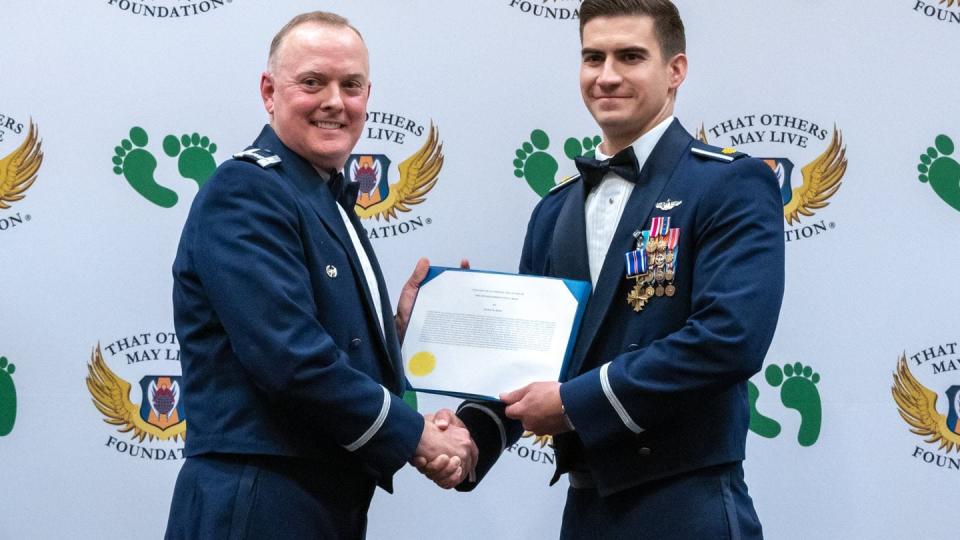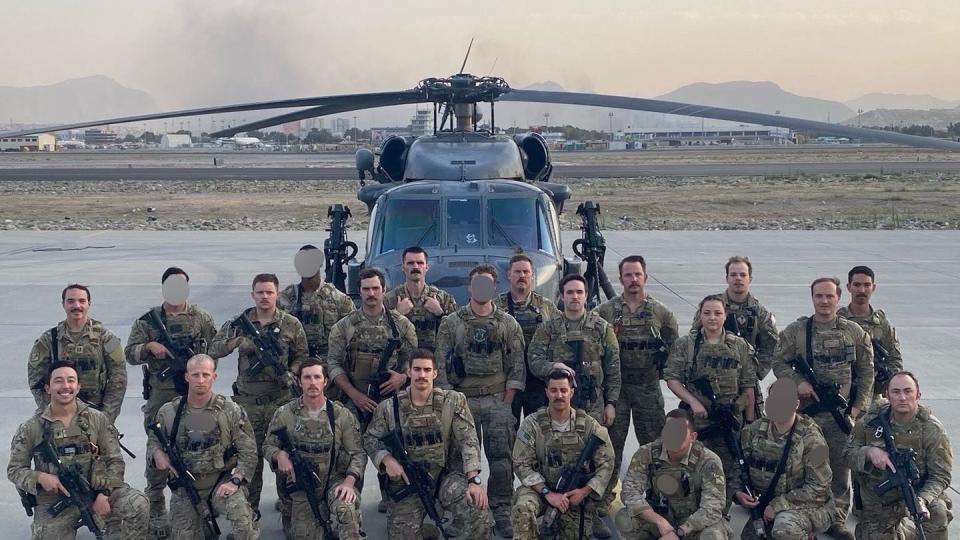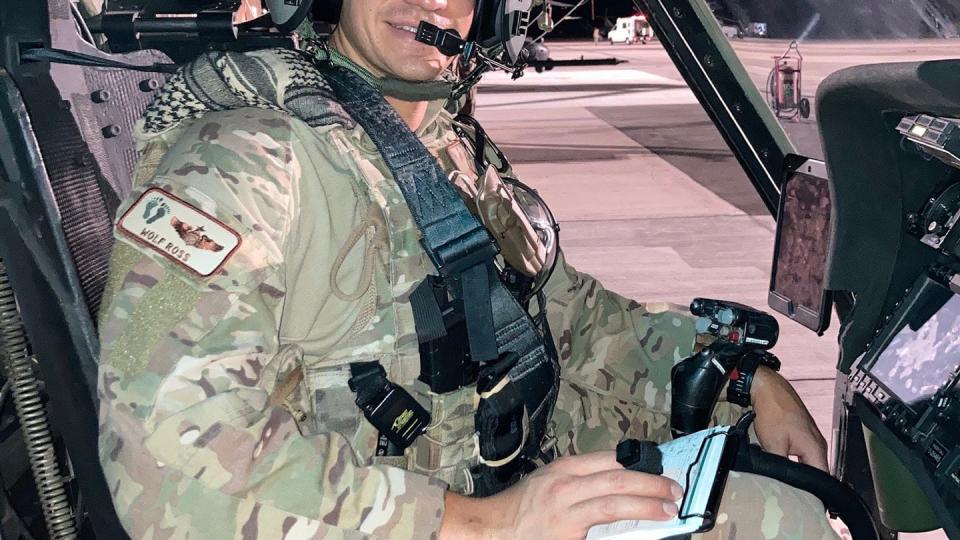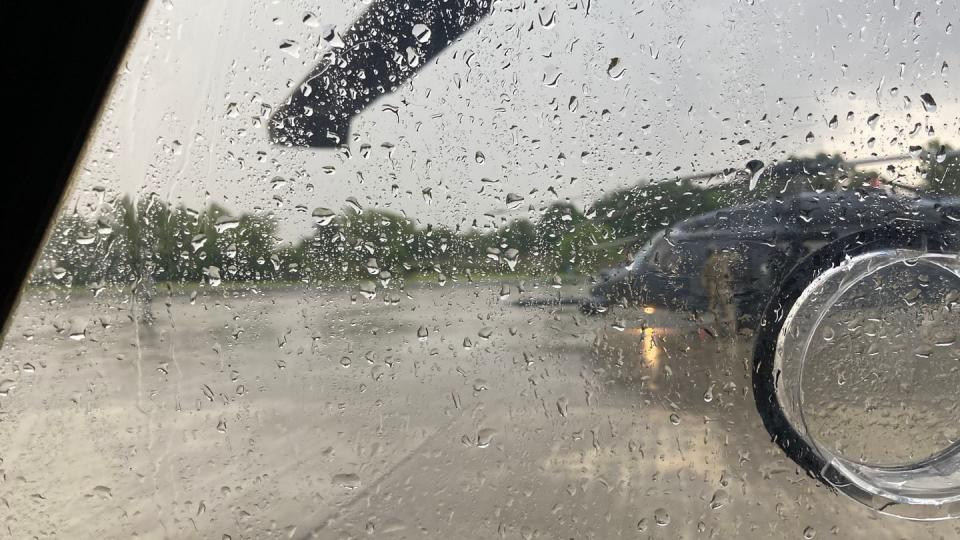Helicopter pilot details final days of HH-60 rescue ops in Afghanistan
There weren’t supposed to be gunshots.
Fire rang out across a valley north of Kabul, where Air Force Maj. Mark Ross was leading a pair of HH-60G helicopters on what would become their final practice mission in Afghanistan on Aug. 1, 2021.
The airmen were trying to ensure their Pave Hawks could reach a refueling plane that was waiting across the mountains. Bagram Air Base, abandoned by the U.S. weeks earlier, lay dark as they passed overhead.
But U.S. intelligence-gathering in Afghanistan had dwindled as American forces departed. Ross didn’t know that the valley — neutral territory just days earlier — had become a staging area for Taliban fighters.
A firefight ensued between the Taliban and the aviators, killing three enemy combatants, according to the citation for an Air Force Commendation Medal Ross received in April 2022. The helicopters managed to escape unscathed; the airmen returned to Kabul unharmed.
“My formation was engaged with small arms [on] three different occasions,” Ross, now a Reservist at the 305th Rescue Squadron at Arizona’s Davis-Monthan Air Force Base, told Air Force Times in a recent interview. “We were very fortunate because the aircraft didn’t get hit.”
The skirmish highlighted the growing unpredictability of what would prove among the most chaotic and unusual U.S. military operations in recent history: America’s withdrawal from Afghanistan as the Taliban returned to power.
Ross and others from the 66th Rescue Squadron at Nellis AFB, Nevada, were dispatched to Kabul as part of a personnel recovery team tasked with rescuing troops and civilians who were stranded across Afghanistan in the waning days of America’s nearly two-decade war there.
Over the course of the eight-week deployment, Ross helped plan rescue missions for those stuck behind enemy lines as the Taliban regained control of the country, and usher fleeing families to safety at Hamid Karzai International Airport.
And he orchestrated the final evacuation of three HH-60s to Pakistan on Aug. 29, 2021, for which he was awarded the Distinguished Flying Cross, the Pentagon’s highest award for extraordinary aerial achievement, in September 2023.

“Ross led the last HH-60G rescue helicopters out of Afghanistan … across hundreds of miles of hostile territory through widespread thunderstorms on a zero-illumination night to an airfield in Pakistan,” the award citation read. “The professional competence, aerial skill and devotion to duty displayed by [then-]Capt. Ross reflect great credit upon himself and the United States Air Force.”
Saving the stranded
Ross arrived in Kabul on July 19, 2021, to a nation in crisis and battlefield conditions that were changing by the day.
Without other helicopter crews around to hand off operations to the newcomers, Ross worked with American pararescuemen and embassy staff to understand what lay ahead.
The task force where Ross served as a helicopter flight lead fielded calls from others across Afghanistan looking for a ride out of the country. The team would also be dispatched to find any American aviators in case of an ejection or aircraft crash in Taliban-controlled areas.
The Air Force’s HH-60 Pave Hawk, a cornerstone of the military’s search-and-rescue enterprise since the 1980s, was the go-to airframe for the toughest recovery missions, Ross said. Pave Hawks carry enough fuel and onboard sensors to slide into areas where others would be stymied by long distances or poor visibility, Ross said.
Even with the right aircraft, weight and speed mattered. Keeping too much fuel and gear on the helicopter could cost them the mission, Ross said. Keeping too little could cost them their lives.
“A lot of those [missions] are going to be six- to 10-hour flights,” Ross said. “Your fuel is your ticket home.”
Then there was Afghanistan’s inhospitable landscape. Its vast sands, when whipped up by helicopter rotors, can transform open air into a blinding, gritty haze. The Hindu Kush mountains that snake across much of central and eastern Afghanistan prevent low-flying aircraft from easily traversing the country.
And with enemies popping up in new places by the day and a shrinking number of friendly outposts offering places to land, time was dwindling before safe routes would become impassable.
Ross and his team relied on a map that illustrated the safest flight routes and where they might come under fire. Much of Afghanistan remained green, signaling friendly territory, Ross said. But other colors were spreading: gray, in neutral areas; and red, where insurgents had regained control.

In one case, Ross’s team concocted a plan to rescue a group of six Americans and Europeans who were hiding in the Taliban-controlled town of Shindand. A dying cell phone was their lone means of communication with the outside world.
The group would sprint to a nearby soccer field and flash a special hand signal so an incoming helicopter could identify them as the stranded Westerners, Ross said. The aircraft would swoop low, troops would pull the evacuees onboard and the pilot would zip away after a scant few minutes on the ground.
But because the plan was so risky, Ross said, the U.S. opted to secret the group out of Shindand via more clandestine means — avoiding the potential civilian and military casualties that may have resulted.
Ross said his team also laid out a plan to pick up an American reporter near Mazar-e-Sharif who ultimately found a different escape route.
By early August, the helicopters had stopped flying. The Taliban were the closest they’d come to reclaiming control of the country in nearly 20 years. Ross’ map gradually turned gray, then red, as each province fell into enemy hands.
“When we would go out and fly, we were getting constantly shot at because the Taliban had basically encircled Kabul,” Ross said.
Without reliable intelligence about the security situation on the ground to ensure their safety, the aviators had to stay put.
The HH-60s sat unused in Kabul for nearly a month as the Taliban toppled the capital city, sealing their return to power. Airmen periodically powered up the Pave Hawks to ensure they were still working, Ross said, but tried to stay off the airfield that had become a target.
As Ross and his teammates halted helicopter operations, they turned to another rescue effort: Operation Allies Refuge, which ushered more than 124,000 Afghans, Americans and other Westerners to safety in the largest evacuation of noncombatants in U.S. history.
When Afghan civilians and Taliban fighters overran the airfield in mid-August 2021, Ross “filled a critical shortfall by coordinating ground operations of 16 cargo aircraft” so those flights could resume, according to the citation accompanying his Air Force Commendation Medal.
Meanwhile, text messages from search-and-rescue counterparts in the Afghan military, dual citizens and others began pouring in, each seeking a way through the gates at Hamid Karzai International Airport. Ross would direct the contacts to get as close to the entrance as possible so that U.S. troops could identify the evacuees and whisk them through the mob to safety.
Ross, whose pregnant wife was waiting at home, said he was particularly struck by the plight of babies in danger of being crushed by the crowd. If families could make it to a 2-foot-long rip in the fence, he thought, the children would have a better shot at survival.
“‘[You’re] going to hand the baby through, so the baby doesn’t have to go through the violent mosh pit area, and then we’re gonna get the rest of the family through,’” Ross recalled telling families.
He and other troops were able to save multiple children that way, he said.
Ross himself “ensured the processing and recovery of 24 refugees, including two infants,” according to the Air Force Commendation Medal citation.

‘Pedro’ leaves Afghanistan
As the withdrawal lurched toward its Aug. 31 deadline, Ross began crafting a plan to bring his team home alive.
Rather than loading the helicopters onto C-17 cargo planes, robbing evacuees of precious space on outbound aircraft, officials decided the HH-60 crews would fly themselves out.
The nearest U.S.-run base was a 10-hour trek — potentially too far for helicopters and aircrew that hadn’t warmed up for weeks. Instead, Ross said, they would head two-and-a-half hours east to Pakistan.
“We actually flew those helicopters out of there with a lot of systems that were not working — even flight control issues,” Ross said. “It was the level of risk that we were willing to accept, because the alternative was leaving the helicopter there to be destroyed.”
They lifted off under the cover of darkness on the morning of Aug. 29, 2021, with Ross’ helicopter in the lead. Three Pave Hawks, packed with about two dozen troops who remained in Kabul, called in a final departure for “Pedro” — the HH-60′s famed call sign in Afghanistan.
“That was kind of surreal,” Ross said. “That was probably the last time the ‘Pedro’ call sign was going to be used in Afghanistan … since shortly after 9/11.”
Widespread thunderstorms closed in as the fleet neared the Pakistani border. Without enough gas to make it back to Kabul and no safe place to land in northwestern Pakistan, Ross radioed air traffic controllers to request entry into Islamabad.
The Pakistanis hesitated to let them in, Ross said, because the hastily planned escape had left the helicopters without the usual credentials needed to enter foreign airspace.
But someone far up the chain of command had called in a favor: President Joe Biden had secured approval from Pakistani officials for the airmen to land at an airport in Islamabad, Ross said he was told. (A White House spokesperson did not confirm whether Biden personally made the request.)
“They’re like, ‘Who granted your approval?’” Ross said. “I responded with, ‘The president of Pakistan passed a verbal approval.’”
A long pause ensued.
“Then he responded back with, ‘Pedro … continue on course,’” Ross said. “All of us took a huge, deep sigh of relief.”
More complications arose: A thick layer of clouds blocked the fleet’s view of the ground. Their flight software hadn’t been preloaded with maps of Pakistan that would flag potential hazards like cell towers. Terror groups like the Islamic State were camped in the mountains, making emergency landings even more treacherous.
Their best option, Ross decided, was to “scud-run” the last 25 miles to Islamabad through heavy rain. The trio of helicopters would fly just 100 feet off the ground, at less than 50 mph, without the ability to see more than 250 meters ahead, according to his award citation.
“I found a spot in the clouds [where] I could see the ground, and then we basically dove through that, down towards the treetops,” Ross said.
He led the procession on, peering into the rain to spot downed power lines so the trailing helicopters could dodge them.
They touched down at the airfield moments before the deluge would have made it impossible to land, he said.

American diplomatic staff met the airmen and brought them to the U.S. Embassy in Islamabad to sleep. Military transport planes arrived soon afterward to ferry Ross, his teammates and the Pave Hawks back to the United States.
“We knew that we were doing everything we could,” he said of the team’s role in the Afghanistan withdrawal and their own evacuation. “I’m proud that I got to be a part of it, and represent what we could do and get everything done [with] the best possible outcome.”
Two years later, Ross was awarded the Distinguished Flying Cross.
“You have set the standard in what you do,” Col. John Creel, deputy commander of Air Forces Southern, told Ross at the September ceremony, according to a release. “You didn’t leave anyone behind, and you didn’t leave any equipment behind for the Taliban to use. That is very commendable.”
It was a full-circle moment for Ross, whose grandfather — an Air Force transport and bomber pilot — earned the same honor for evacuating more than a dozen people from an airfield under fire during the Vietnam War.
“That always resonated with me,” Ross said. “It was never a question for me, what I was going to do when I grew up.”

